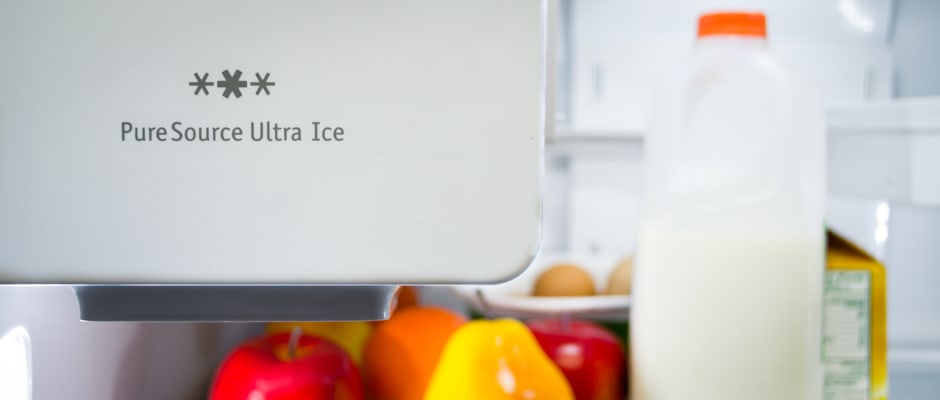Pros
Cons
Design & Usability
Designed to be cool.
It's not always feasible to have a built-in fridge in your kitchen. Fortunately, counter-depths allow for the built-in look at a slightly friendlier price. Aesthetically, this 28.5-inch deep model sure looks like the silver bullet your kitchen needs. With simple text and minimal controls, Frigidaire's treatment of the control panel keeps it from being an eyesore. Inside, the design looks are on par with the façade, with four shelves and three drawers bathed in blue-white light. The icemaker does take up a large portion of the top left. It's done in a way that doesn't really offend the eye, but it definitely robs the already small fridge of useful space. In the freezer, a shallow drawer and a larger tub drawer are equally well-lit for convenience.
But while the design looks impressively luxurious, usability slightly lags. The right side has three movable shelves above one another, but there's not really any room to move them around. If you were to own this fridge, you'd probably want to ditch one of the shelves to make more space for items that aren't just four inches tall. All the shelves move in interesting ways—see the Vine below—but don't slide as smoothly shelves in a $2,899 fridge should. Accessing items in the rear isn't so difficult, due to the shallow depth, but this fridge does feel a little cramped. The freezer feels especially small, but access is easy with the pullout bottom and sliding wire drawer.
{{vine 'hHAmABKlJVw'}}
Performance & Features
An middling performance from an expensive fridge.
This Frigidaire's performance numbers aren't bad, but they aren't really that good either. The overall temperature of our test food averaged three degrees above display's 37°F, but only showed middling consistency. The crisper drawers, located in the slightly warmer bottom of the fridge, didn't do a great job locking in humidity, so produce might not last as long as you'd like. In the freezer drawer, our sensors recorded a very accurate average temperature barely above the thermostat reading of 0°F. But further examination of the data indicated that the numbers weren't so consistent throughout the freezer's testing period. These fluctuations above and below 0°F put your food at risk of freezer burn.
{{ gallery "design", }}
While this Fridgaire's biggest feature is most certainly its counter-depth dimension, this fridge boasts movable shelves, humidity controlled drawers, three genres of water—cold, cubed, or crushed. But even with those, it's a pretty basic fridge. No smart grid or sparkling water features here.
For in-depth performance information, please visit the Science Page.
Conclusion
It's good, but it just has the wrong price tag.
The Frigidaire FGHF2366PF is not a bad fridge. Though its test results are far from the top, they're equally far from the bottom. But even with the pleasing aesthetics and counter-depth dimensions, it's probably not going to be the best choice for your money. There's just better options out there that don't tax the wallet so much. But if you find this model on sale for a price that reflects its average performance, this could be a satisfactory way to bring some style to your kitchen.
The Cold Hard Facts
There's not a lot the Frigidaire FGHF2366PF (MSRP $2,899) does wrong. It performed adequately in all of our lab tests. But few of the tests showed any sort of the high performance and temperature control we'd expect from a fridge in this price range, even though it's one of the relatively small number of products that can fill a counter-depth hole in your kitchen.
Temperature Performance
Our test food averaged a temperature of 40.1°F, a few degrees higher than the thermostat's setting of 37°F. While that's certainly not unusual—$400 fridges often exhibit this temperature accuracy—some temperatures climbed above the 41°F mark. That's the key temperature for inhibiting bacterial growth. The consistency of these numbers throughout the testing period was about average, deviating a degree in either direction. Toward the bottom, we recorded temperatures slightly warmer (41.2°F) than the top (39.4°F) and the middle (39.8°F) of the cavity. That's not unusual, and actually is a good thing for storing produce, which benefits from a slightly warmer temperature than dairy, for instance, which needs to be kept cold.
The freezer drawer kept everything at a satisfactory 0.5°F, half a degree off the thermostat setting of 0°F. Unfortunately, the temperatures recorded vacillated a bit, with the deviation from the mean averaging around a degree and a half. This may cause some freezer burn.
Moisture Retention
The crisper drawers weren't useless by any means, but they allowed 0.23 grams of water to escape per hour. That isn't a great result for a higher end fridge like the FGHF2366PF. It definitely will keep the lettuce crisp for a few days, but don't put off eating your veggies for too long.
Freezing & Thawing
The freezing test was the Frigidaire FGHF2366PF's high point. Just an hour and two minutes after we placed room temperature food substitutes into the freezer, their interior temperatures dipped below 32°F. The freezer might not be that consistent, but it's sure effective. It also demonstrated excellent insulation, as the drawer stayed below freezing for over 36 hours after we pulled the plug, giving your food a reprieve while the power company gets things running again.
Storage Space & Energy Efficiency
We measured about 9.7 cubic feet of usable space in the fridge, and 4.5 in the freezer. These numbers are less than the total volume in the manufacturer specs, but usable space is different from volume. Comparing our measurements with the fridge and freezer volumes of 15.7 and 6.9 cubic feet respectively, the freezer uses its space much more efficiently.
A month of operation costs around $4 (if your kilowatt costs $0.09), and when we factor in the storage space, the fridge's 0.10 kWh per cubic foot appetite is good, but certainly not enough to be listed in any "pro" columns.
Meet the tester
Ethan writes reviews and articles about science for Reviewed.com, and edits the Science Blog. He's originally from Vermont and thinks the bicycle and guitar are examples of perfected technology. Prior to Reviewed.com, he studied furiously at Middlebury College.
Checking our work.
Our team is here to help you buy the best stuff and love what you own. Our writers, editors, and experts obsess over the products we cover to make sure you're confident and satisfied. Have a different opinion about something we recommend? Email us and we'll compare notes.
Shoot us an email

